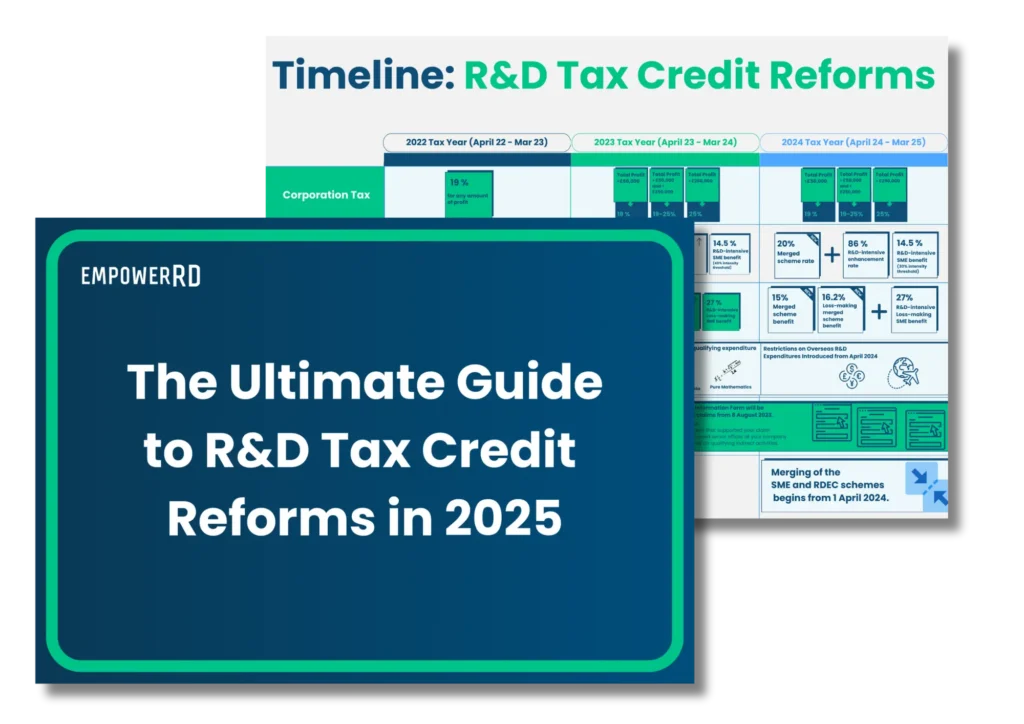It’s no secret! The SaaS industry is thriving and showing no sign of a slowdown. As a specialist R&D provider, we’re right in the thick of it, working with some of the most innovative UK SaaS companies in both B2B and B2C sectors. The industry is a hotbed of great ideas, with many companies using technology to deliver great products to the market. But let’s not forget that managing finances in the SaaS world is crucial.
The SaaS business financial model is unique, and it definitely has its own set of challenges and opportunities. Mostly subscription-based, SaaS startups must carefully handle recurring revenue, high customer acquisition costs, and the constant need for innovation to keep ahead of the game.
With all that in mind, our goal is to arm you with practical strategies for financial planning, customer acquisition, and making the most of funding opportunities for growth and innovation.
Get to grips with SaaS finance specificities
The world of SaaS finance is like its own little universe, revolving around the subtleties of subscription-based revenue, high transaction volumes, and specialised metrics that are vital for keeping tabs on performance and growth.
If you’re going to navigate this universe effectively, you’ve got to get to grips with these specificities. They’re not just nice-to-knows, they’re need-to-knows. And once you’ve got them down, you’ll be in a much stronger position to handle your financial management and strategic planning.
Subscription model complexity
When talking about the subscription model in business, it can have its pros and cons. Whilst it can provide a steady stream of income, it does come with some tricky challenges, especially for accounting and financial management.
Subscriptions mean you have to recognise revenue over a period of time, which is unlike single sales. This introduces something called deferred revenue. Essentially, when a customer pays upfront for a service, only a part of that payment is recognised as revenue while the service is being provided. This helps you stay in line with accounting standards and also gives you a clearer picture of your earnings.
And let’s not forget about Customer Lifetime Value (CLV). This metric tells you how much a customer is worth over the course of their relationship with your business. It’s a key tool for SaaS companies, helping to guide decisions around pricing, budgeting, and how much you should spend to acquire new customers. By understanding CLV, you can better allocate your resources and maximise profitability.
High transaction volumes
SaaS companies often process a high volume of transactions due to their broad customer bases and recurring billing cycles. This necessitates efficient payment and accounting systems to manage subscriptions, renewals, and cancellations. Automation becomes essential to handle operations at scale while maintaining accuracy and minimising overhead.
Unique financial metrics
Critical to SaaS financial health are metrics like Monthly Recurring Revenue (MRR) and Annual Recurring Revenue (ARR), illuminating the steady flow of subscription income. Customer Acquisition Cost (CAC) and churn rate further reveal the effectiveness of marketing efforts and customer satisfaction, respectively. Monitoring these metrics is vital for forecasting, budgeting, and strategizing for sustainable growth.
In mastering these financial specificities, SaaS businesses can navigate their unique challenges and capitalise on the opportunities presented by the subscription model, laying a foundation for long-term success.
Deep Dive into Metrics
- Monthly Recurring Revenue (MRR) and Annual Recurring Revenue (ARR) measure predictable revenue from subscriptions, which is crucial for forecasting and valuation.
- Customer Acquisition Cost (CAC) quantifies the expense of acquiring a new customer, which is essential for evaluating marketing efficiency.
- Churn Rate indicates the percentage of customers who cancel their subscriptions, a critical measure of customer satisfaction and product fit.
The pillars of financial planning for SaaS startups
When planning finances for a SaaS startup, you need to think about the now, the next, and the later. Each stage is key to building a business that can grow and stand the test of time.
Short-term financial planning
Start by keeping an eye on your cash flow and keeping your day-to-day costs low. This helps your business stay afloat. It’s also a good idea to set some money aside for a rainy day. This emergency fund can help you weather the financial storms that come your way.
Setting mid-term goals
As your startup grows, start setting clear targets for your revenue, product development, and customer growth. These goals can help guide your company’s path and make sure you’re heading in the right direction.
Planning for the future
For long-term success, plan for your business to grow and expand into new markets. You might also want to think about how you could exit the business or attract big investors. A strong financial base, steady growth, and the ability to scale up your operations can make your company more appealing to investors and partners.
In short, SaaS startups should take a step-by-step approach to financial planning. They need to balance their immediate needs with their future goals. This can help them grow, attract investment, and set themselves up for long-term success.
MVP and budgeting
In the world of SaaS startups, launching a Minimum Viable Product (MVP) – that’s a product with just enough features to satisfy early customers and provide feedback for future development – is crucial. This process needs careful budgeting and strategic investing. You want to balance creating something innovative with keeping your financial health in check.
Budgeting for your MVP
When you’re setting a budget for an MVP, you’re basically allocating funds for initial development, marketing, and setting up ways to get feedback from your first users. It’s all about covering the basics that will get your product into the market without going overboard on extra features or marketing tactics that don’t align with your core offering. Accurate cost forecasting can help you bring your MVP to life without endangering your startup’s financial stability.
Investing wisely and keeping costs in check
The secret sauce for MVP development is investing in features and marketing efforts that meet customer needs and market demand. Use customer feedback to decide which features are absolute must-haves for your MVP, focusing on those that solve the biggest problems your target audience faces. This approach not only ensures maximum return on your investment but also prevents you from wasting resources on less critical aspects of the product. Balancing innovation with cost control is key, to helping your startup stay flexible and responsive to market feedback without stretching its budget out of shape.
Cash flow vs. profit: What matters more for SaaS startups?
Why cash flow is key
For early-stage SaaS companies, maintaining a positive cash flow is often more important than achieving immediate profitability. Cash flow is the money that keeps your business running from day to day, allowing you to invest in growth even before you start making a profit. It’s the lifeline of your company, covering everything from paying your employees to the costs of developing your product.
Managing your cash flow
There are several strategies to effectively manage your cash flow. You can keep overhead costs low by running a lean operation, negotiating good payment terms with customers for quicker cash inflows, and building strong relationships with suppliers to secure flexible payment terms.
As mentioned before, having a reserve of cash can also be a good idea, acting as a safety net that provides financial stability and the flexibility to handle any unexpected challenges, especially when it comes to short-term financial planning.
Driving revenue growth through customer acquisition and retention
The dual strategies of customer acquisition and customer retention are pivotal for SaaS growth. Retention is cost-effective, fostering a stable revenue base, while acquisition drives business expansion and market share growth.
Strategies for both
To engage customers and drive growth, businesses should leverage targeted marketing strategies for acquisition and create value-driven product experiences for retention. Aligning sales and marketing efforts enhances customer acquisition efficiency while providing excellent customer service and continuously improving the product encourages retention. Important metrics to monitor include Customer Acquisition Cost (CAC), Customer Lifetime Value (CLV), churn rate, and Monthly Recurring Revenue (MRR), as they provide insights into the effectiveness of these strategies.
Innovation and R&D funding
Leveraging R&D tax relief
R&D tax credits are a critical tool for offsetting the costs associated with innovation and new product development, allowing SaaS companies to reclaim expenses spent on R&D activities. This financial support can make a significant difference in a startup’s ability to innovate and stay competitive. For instance, R&D-intensive SMEs that invest 30% or more of their total expenditure on R&D can claim up to 27% of their total R&D costs.
Exploring funding options
Diverse SaaS funding options are available for SaaS startups, each with its advantages and drawbacks.
Equity financing, like Venture Capital (VC), can offer substantial investment but often requires giving up equity. Angel investors provide not only funding but also valuable mentorship, though the amounts may be smaller.
SaaS companies are increasingly exploring Revenue-based financing as an alternative. Unlike traditional loans with fixed monthly payments, RBF allows you to repay investors with a percentage of your monthly or quarterly revenue.
Bootstrapping, or self-funding, allows for complete control but limits the resources available for growth. Each funding route requires careful consideration to align with the company’s growth strategy and long-term vision.
Building a SaaS finance tech stack
To streamline financial operations, SaaS companies should look towards building a finance tech stack that does more than just traditional accounting. This stack should include tools for sales forecasting, project management, invoicing, payments, HR and payroll, and expense tracking.
Key tools in your stack
- Sales forecasting: Use tools like Salesforce or HubSpot to gain insights into future revenue by analysing sales pipelines and customer interactions. This can help your SaaS business predict cash flow needs and identify growth opportunities.
- Project management: Platforms like Asana or Trello can help efficiently allocate resources and budget for product development and marketing efforts, ensuring projects stay on schedule and within budget.
- Invoicing: Automate invoice creation and distribution with solutions like FreshBooks or QuickBooks to streamline billing cycles and reduce administrative tasks.
- Payments: Payment processors such as Stripe or PayPal can securely handle subscription and one-time payments, supporting a variety of payment methods and currencies for global customers.
- HR and payroll: Systems like Gusto or ADP combine payroll processing with HR management, ensuring effective and efficient management of employee compensation, benefits, and compliance.
- Expense tracking: Apps like Expensify or Xero offer real-time tracking of business expenses, aiding in budget management and financial analysis.
The power of integration
Integrating these tools into a single finance tech stack can greatly improve efficiency and accuracy across all financial operations. It offers real-time insights into your financial health, streamlines workflows, and supports strategic decision-making with a comprehensive view of finances, from revenue forecasting to expense management.
For more info, read our article: What is the best finance tech stack for a growing business?
Revenue growth through pricing strategies
Choosing the right pricing model
The right pricing model can be a game-changer for revenue, customer acquisition, and retention. Here’s how you can leverage different models:
- Tiered subscriptions: Create subscription tiers to cater to different customer needs and budgets. This can pave the way for up-selling and cross-selling as customer needs change.
- Freemium models: Entice a broader audience with a free basic version of your service, with the option to upgrade for premium features. This can drive user acquisition and monetise engaged users over time.
- Usage-based pricing: Charge based on consumption to align your pricing with the value customers get from your service. This can resonate with customers with varying usage needs and boost revenue as usage grows.
Adjusting pricing: The what and why
Pricing isn’t static. It needs constant tweaking based on several factors:
- Feedback and analysis: Use customer feedback and data analytics to understand how your pricing impacts user behaviour and your market position. Regular interaction with your user base can give you insights into what customers value most.
- Operational costs and market trends: Monitor these to ensure your pricing is sustainable and competitive. Adjusting pricing based on these factors helps maintain a healthy margin while appealing to your target market.
- Value alignment: Your pricing should reflect the value your service provides. As you enhance your service, revisiting your pricing helps justify your value proposition to customers.
Remember, strategic pricing requires ongoing attention. Regular reviews and adjustments are crucial to stay competitive, maximise profitability, and align with customer expectations and perceived value. Don’t just set it and forget it!
Unlocking success in SaaS: Essential financial strategies
Navigating the SaaS landscape requires a keen understanding of essential financial strategies and tools, as highlighted in this article. From mastering cash flow management and key metrics to leveraging strategic pricing models, these elements form the backbone of a successful SaaS venture.
Are you ready to take your SaaS business to new heights? Effective financial planning, paired with customer-centric growth strategies and innovation, is the key. It’s not just about surviving—it’s about thriving and becoming a formidable player in the competitive SaaS market.
But how do you achieve this?
By embracing these strategies, you can optimise your operations and position your business for long-term success. Remember, the digital landscape is always evolving. Hence, staying ahead requires adaptability and strategic foresight.
So, are you prepared to take the reins and steer your SaaS company towards sustainable growth?












